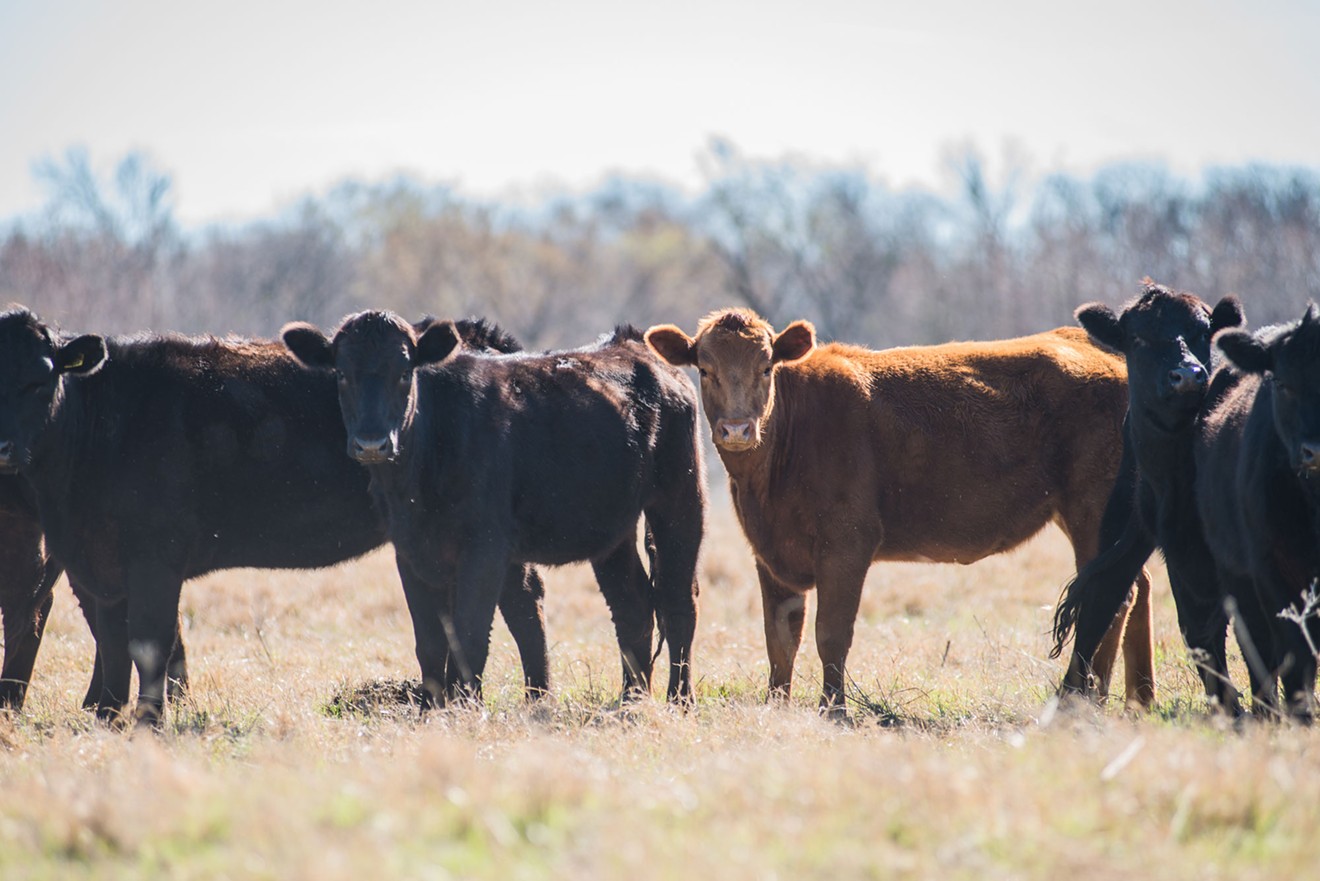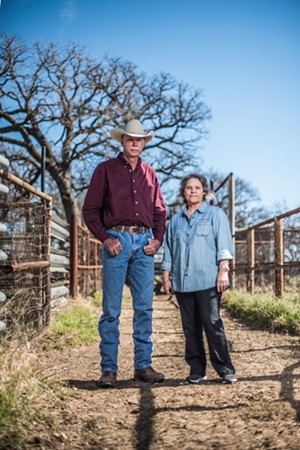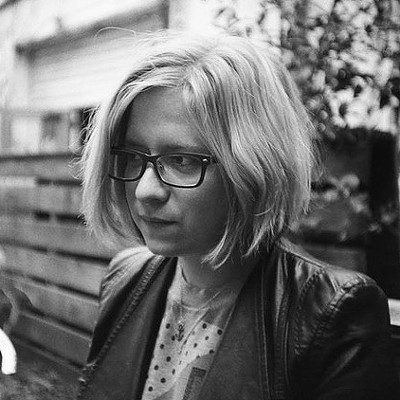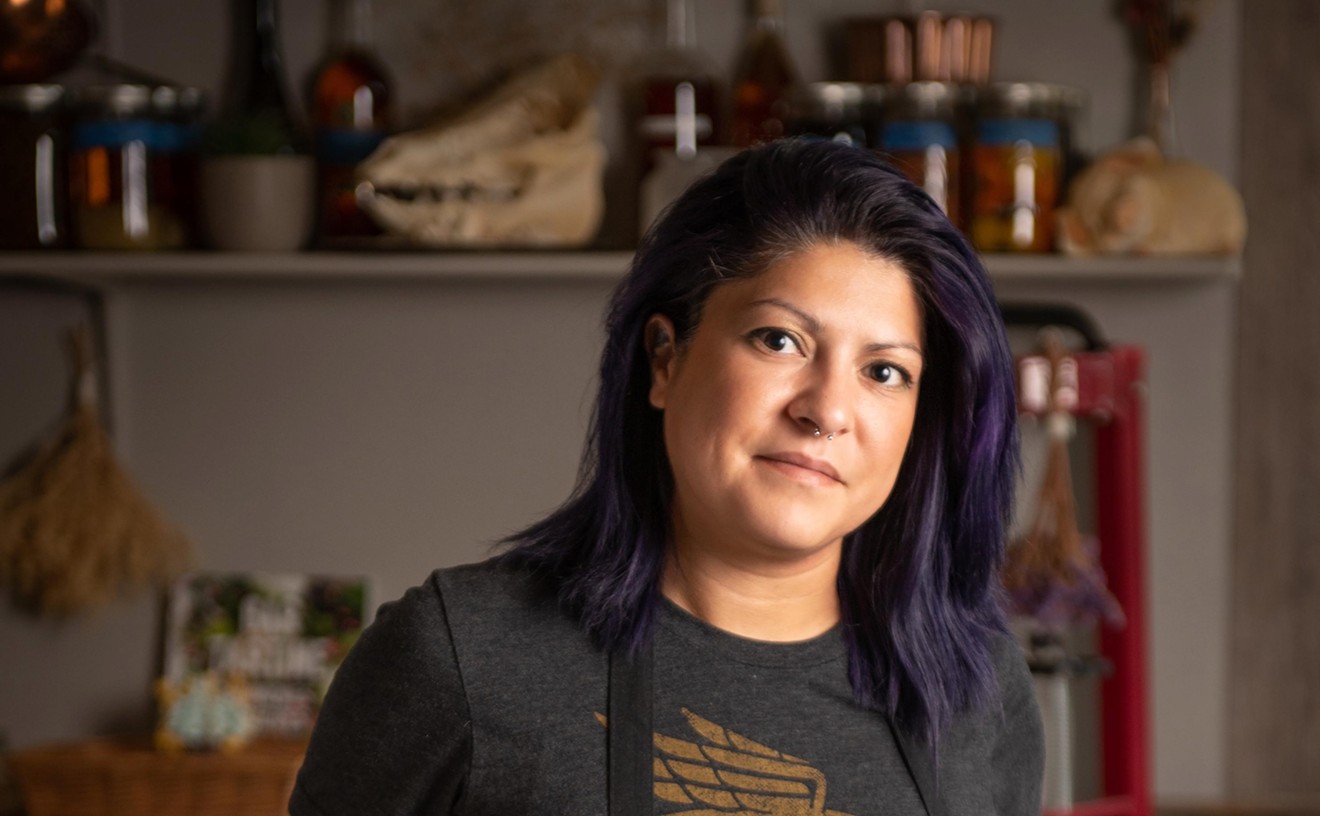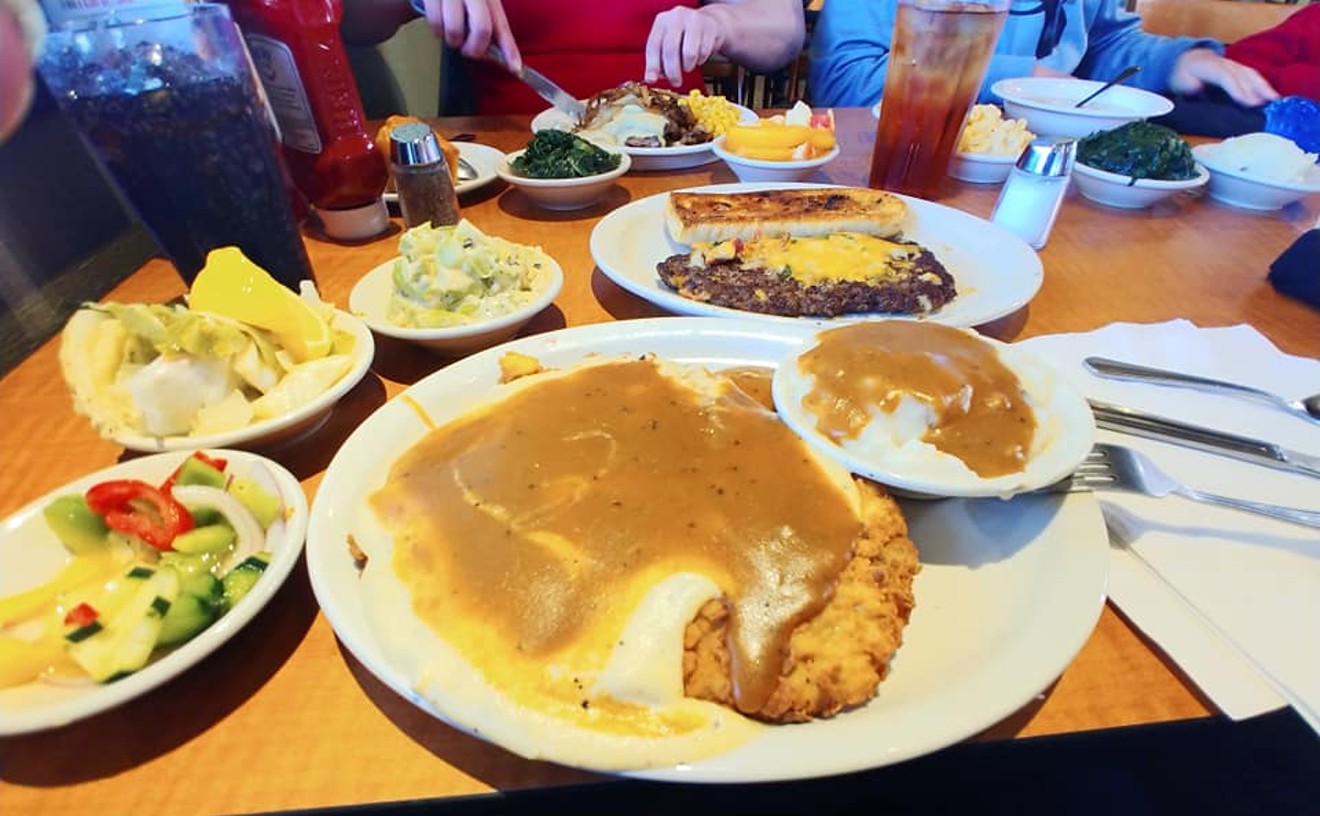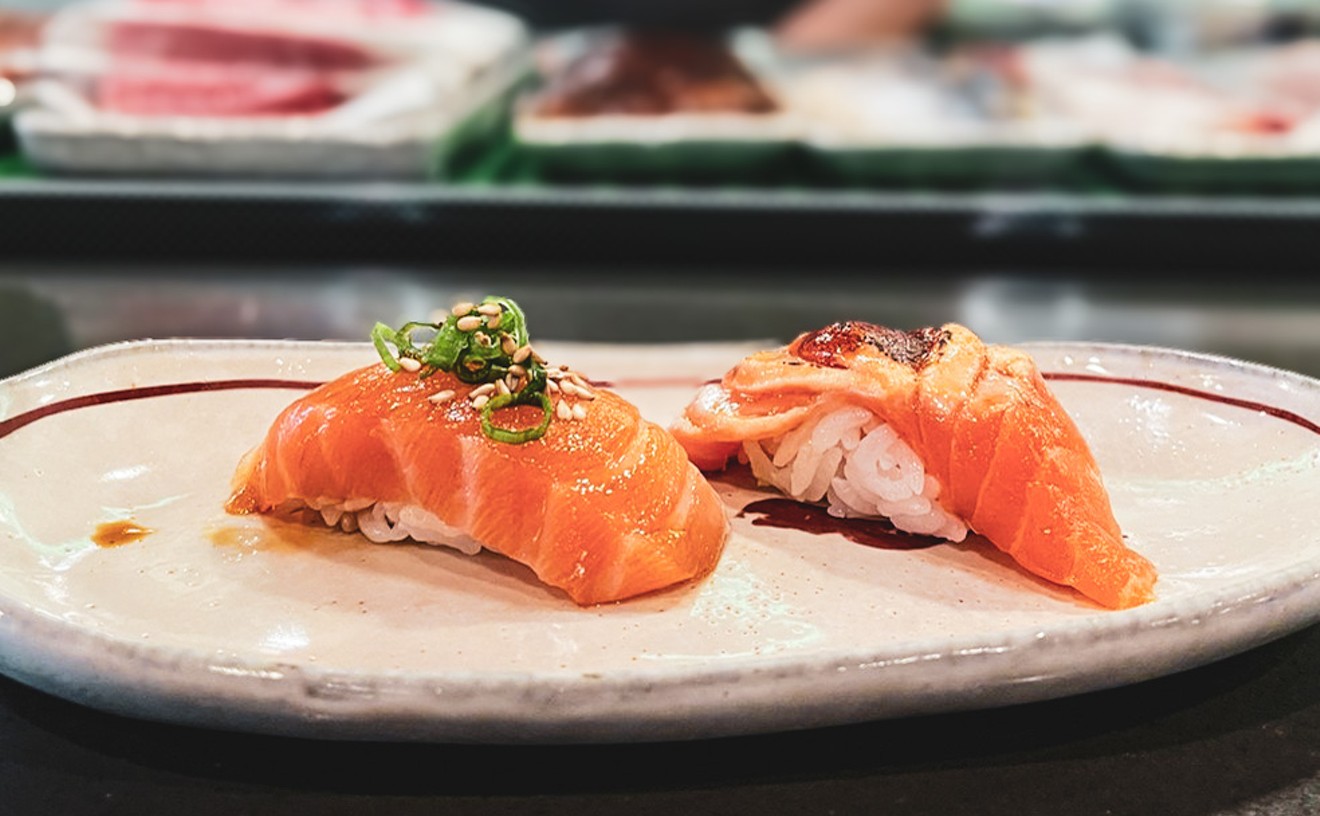On Ross Avenue, sandwiched between a craft beer-heavy sports bar and a specialty booze store selling high-end bitters, a small storefront serves as an extension of Jon Taggart’s rolling, grassy North Texas cattle ranch.
The minute you step inside the market, you can’t miss him: Taggart, thumbs hooked in his pockets, standing in a massive photo mural behind the register. He’s tall and lean in jeans and a button-up, cowboy hat, mustache and all, standing proudly in front of a few head of cattle. Whatever image pops into your head at the words “Texas cattle rancher” is not far off from Taggart himself.
Until he gets to talking.
“I describe myself as a conservative environmentalist,” Taggart says in a Texas drawl, sitting in the office of the boucherie and meat market situated near the ranch he leases in Grandview. Taggart, who runs Burgundy Pasture Beef with his ex-wife Wendy Taggart, is no stranger to traditional cattle ranching.
“Ranching, I’ve done it all. I’ve done the cow-calf. I’ve done the feed yard. I’ve done the herbicides. I’ve done it all,” he says, looking out the window toward the land his family has leased for ranching since 1886.
“We did all that, and we spent a lot of money ... and weren’t making a living,” he says.
So, years before grass-fed and grain-free were part of the standard American food vernacular, Taggart decided to try something different. He converted his 13-head herd to completely grass-fed — no hormones, no antibiotics, no feed lots. Just shy of 20 years later, he's got 200 head of grass-fed cattle on that land, and Burgundy Pasture Beef has become a multifaceted operation with a ranch, processing plant, a cafe and three meat markets, the latest of which opened just before Thanksgiving on Ross Avenue. College ranching programs bring students by the busload out to Taggart’s ranch, which has become a case study in biodiversity, sustainable ranching and new ranch technology, and Texas grass-fed ranchers are driving cattle up to five hours just to have Taggart’s team handle the processing.
And it all started in 1999 with those 13 head of cattle.
To the untrained eye, Taggart’s ranch looks like all the other endless expanses of prairie that stretch for miles around the tiny town of Grandview, but creating the grassy fields where Burgundy Pasture Beef comes from takes a lot of work and time. Down to the simplest technology, students quickly learn just how much Taggart’s land differs from other ranchers’ spreads that may be as little as a few feet away.
At the basis of Taggart’s system is a straightforward yet overwhelmingly complicated thing: grass.
Texas is the country’s largest beef producer, with 11.7 million head of cattle in 2015, according to the National Cattleman’s Beef Association. Most of the beef we consume is commodity beef, which essentially means that it’s is an amalgamation of animals from all over — you can’t say for sure whether you’re eating a cow from Fort Worth or Woodville, or both. On the other end of the spectrum, you find Taggart’s artisanal, ranch-to-table beef, cut and packaged to his exacting specifications.
There are three phases in the cattle industry: cow-calf, or breeding; then the growing phase, in which a cow grazes in the pasture until it weighs about 750 pound. At that point, the cattle go to a consigned feed yard, a practice that started in the 1950s, says Chris Farley, assistant director of the Texas Christian University’s ranch management program.
“We figured out that we can increase their gain and taste preference if we put them on a grain-based diet, mainly corn,” Farley says, likening the feed lot to a hotel where cattle dine from a veritable buffet until they nearly double in size, weighing around 1,300 pounds at the time they’re slaughtered. Compared with the 1950s, Texas currently has about one-third as many head of cattle, but we produce substantially more beef, Farley says.
“In comparing Jon’s and conventional methods, Jon buys them at 500 to 600 pounds and his cattle stay in that grass phase all the way ’til that final harvesting weight, which is gonna be about the same — they may be a little bit lighter than the conventional feed-yard weight. They just don’t have as much fat on them,” Farley says.
Since Taggart isn’t supplementing his cattle’s diet with feed, that means he needs a lot of land for grazing — and a lot of grass. Back in the ’90s, Taggart began the 10-year process of converting the 1,400-acre ranch from plowed farmland to grassy forage. By sticking to native grasses and using sustainable methods, Taggart has been able to increase his forage, but it also means his cattle’s food source is 100 percent dependent on rainfall. He uses solar wells, but the water flow is dependent on gravity in lieu of pumps.
Around 2012, Taggart’s system was put to the test when a drought crippled Texas and most cattle ranchers — Farley included — were forced to sell off their herds.
“When everybody sold out — including myself — he was a good manager,” Farley says, “and because he was managing his forage properly, he maintained his herd through that drought and came out looking pretty shiny. That’s something to brag about.”
Taggart didn’t have to sell off a single head of cattle, he says. When students visit his ranch, he uses an iPhone app to take the temperature of his soil and the soil of the ranch adjacent to his. In the hottest summer months, Taggart says, his soil temperature can be around 20 degrees cooler than that of land that’s only a few feet away. Those cooler temperatures help grasses keep growing even in the harshest Texas summer weather. A cow’s gotta eat a lot of grass to get itself up to 1,300 pounds.
That’s not the only technology he uses. Driving around his ranch on a warm winter afternoon, Taggart also shows off his solar well, and he talks excitedly about iPhone apps that enable him to more easily track things like wind, soil temperature and moisture. He sets up cameras that take photos at the same time every day, creating time-lapse images that he shares with the TCU Institute of Ranch Management.
When Taggart started converting his herd in the late ’90s, his entire ranching philosophy started changing fast.
“The fertilizers, the herbicides — I just didn’t see the benefits coming from the cost, then when you throw the environmental issues on top of that, to me, it just didn’t make sense in my own little world,” he says. “I pretty drastically changed ... the whole way I look at [ranching]. We took 1,400 acres — 900 of it was plowed farmland — and converted that all back to grass over, like, 10 years. It’s kind of a tedious process.”
Taggart bought native grass seed from Turner Seed Co. in Breckenridge, Texas. "It took 10 years because it's a lot of work and very expensive," he says. "Budget and time wouldn't allow me to do it all at once."
Being an early adopter is not without its challenges.
“Everybody thought I was crazy,” Taggart says. “People in the meat industry especially thought we were crazy. If you’re in agriculture, you’re told … that it was not a good culinary product if you didn’t finish it on grain. And I’m here to tell you, I’m amazed every day at how really good the culinary product can be if it’s raised right.”
***

Rachel Wilson drives nearly five hours — from her Wild Earth Texas ranch outside Beaumont — to have her cattle processed at Burgundy Beef Pasture outside Dallas.
John Fulbright
It’s not like she doesn’t already have enough to do. Wilson, 29, is the owner, operator and sole full-time employee of Wild Earth Texas, a ranch just outside of Beaumont, where she raises and retails grass-fed beef. Her family has been in the cattle business a staggering 195 years, specializing in cow-calf production and working in genetics for the past two decades.
After graduating from Texas State University’s agriculture business program, she came home to Beaumont and started work on her family’s ranch. With flowing chestnut hair, warm hazel eyes and a crystal hanging from her neck, Wilson doesn’t exactly fit the profile of a typical Texas cattle rancher. She’s more likely to be sporting a pair of Chaco sandals than cowboy boots, and her friendly, soft-spoken demeanor gives her a calming presence. After college, she spent a year traveling the world, visiting forward-thinking farmers and ranchers and gathering a wealth of knowledge about sustainable and biodiverse agricultural processes. Back on her family’s sprawling LaBelle ranch — flatland and bayous stretching nearly to the Gulf of Mexico — Wilson has been shaking things up a little.
“We decided to start finishing our own beef on our grass, and we really liked the product,” Wilson says. On many Saturday mornings, you’ll often find her at the Beaumont Farmers Market selling cuts of her grass-fed beef to Southeast Texans who are attracted to her practice of raising 100 percent grass-fed, grass-finished, hormone- and antibiotic-free cattle from her sustainable homestead.

Jon Taggart works in the beef processing room at the Burgundy boucherie in Grandview.
Can Turkyilmaz
“He really helped mentor and guide us into what it means to be a grass-fed producer,” Wilson says. “He was really one of the first grass-fed producers in Texas, before grass-fed was a thing. He’s seen the industry grow, and he knows what to expect as far as regulations and labeling and things like that, and that is invaluable when you're trying to navigate this world of red tape.”
She brought her first steer out to North Texas in September and was impressed with Taggart’s work in breaking down and packaging the meat.
“What really sets him apart, for me as a processor, is that he gives me the information — I get a readout of what my product is worth, and poundage and number of cuts, and it’s just data I didn’t have before,” she says. “All of my cuts are together and it’s all uniform. I haven’t gotten a single cut that’s like ‘Oh, I can’t sell this.’ And every beef producer I talk to has this freezer full of cuts they can’t sell.”
For Wilson, who is dealing with more discerning customers, it’s important to know that her cattle will be processed with care — each steer, by the time it’s dispatched, represents two years of hard work. Working closely with a processor means she can also experiment with less traditional cuts of meat.
“Customers can request cuts I’ve never heard of,” Wilson says. “It’s awesome for foodies; people call me up and say, have you heard of beef bacon? It’s nice.”
So far, this system works because Wilson is a small-scale boutique producer. This kind of attention to detail gets much harder when you start working on a larger more industrial scale.
“As my operation grows and his operation grows, we’re just gonna have to play it by ear,” she says, “but I love working with him.”
The 4 1/2-hour drive is rough, Wilson says, but it’s worth it.
“The quality, the mindfulness — I almost started crying when I saw the meat that first time. The way it was packaged, the way it was wrapped; somebody had taken the time and cared as much as I did about those cattle.”
***

Grady Phelan helps Wendy Taggart shelve chickens from his poultry farm, Cobb Creek Farm.
Can Turkyilmaz
Around Thanksgiving 2016, they brought Burgundy Local to Dallas with their Ross Avenue storefront. Suddenly they found themselves in a more sophisticated market, but one where competition is incredibly fierce.
“We did nothing when we opened Fort Worth,” Wendy says. “We got a lot of free press in Fort Worth; Dallas, not so much. It’s been quieter for us. The Fort Worth store does five times what the Dallas store does.”

Jon and Wendy Taggart's daughters, Charley and Patsy, manage the Burgundy Beef Pasture store on Ross Avenue.
Can Turkyilmaz
Customers who walk in inevitably have a lot of questions, and the Taggarts’ daughters are often the ones answering those questions. It’s a real family operation, from Jon on the ranch to Wendy handling the marketing to their daughters working the retail side. Wendy’s marketing acumen has been a big part of Burgundy’s success, Farley says.
Wendy is “a marketing master, and there’s the key to that operation that a lot of people don’t see from the outside,” Farley says. “I think a lot of people come to Jon and Jon will help anybody, but if they go back and they fail, it’s because they don’t have that piece.”
Local, grass-fed meat is still very much a niche market, Farley says, but it’s a market that the Taggarts know well. And that makes all the difference in the world. Right now, their processing plant is booked months in advance, especially as ranchers across the state get wind of what the Taggarts are doing.
“I just do what I do, and there’s a growing group of consumers that want that,” he says.
Burgundy Pasture’s ethos to raise a smaller herd, use no herbicides or pesticides or hormones and to utilize every last part of a dispatched steer means that, inevitably, their product will cost more than commodity beef. According to Consumer Reports, in 2015 a customer buying commodity beef could expect to pay around $4.95 per pound, with grass-fed beef coming in at around $7.38 per lb. Taggart’s premium steaks can sell for upward of $40 each, though anyone who's bought meat at a farmer's market, Whole Foods or Central Market will find comparable, if not lower, prices at Burgundy.
But Taggart has an ace up his sleeve: A consumer base that’s willing to drop a few extra bucks on beef with provenance.

Burgundy Beef's Ross Avenue store sells everything from grass-fed beef to whole rabbit to lamb, stock bones and even pink Himalayan salt.
Can Turkyilmaz
You’ll never catch Jon Taggart speaking ill of commodity beef — it’s where he got his start, after all. But he also has no plans to ramp up his operation to industrial levels; to do so would give him less control over the finished product. A lot of grass-fed beef sold commercially often comes from overseas, but with Burgundy, you know that whatever you’re getting — pastured eggs, whole rabbit, ground lamb, flank steak — comes from small-scale Texas producers who think differently.
“It’s a much more artisanal product,” Wendy says. But in the consumer’s eye, it also has to be worth the price. “If you don’t produce good culinary quality, they don’t come back,” she says.
In the future, they hope to open more stores in North Texas, but have no plans to expand beyond what they can handle while still holding true to their ethos. They also hope to partner with local chefs to create premade meals, popular with millennial consumers, and after that, to partner with a food delivery service to bring those meals straight to the consumer.
“We’re seeing a different demographic in the Dallas store — they’re younger, they live in apartments,” Jon says. “I think the prepared foods might work well for the millennials.”
In the meantime, the Taggarts continue to play a game of hearts and minds, trying to convert consumers one customer at a time.
“I don’t know why Texas can’t once again be famous for producing a grass-fed beef that can be prized anywhere — you can truly graze an animal 12 months a year here. Too far north, it becomes a difficult proposition,” Jon says. “Why not celebrate — and us, from a business perspective — educate people to think of their food in those terms?”
Burgundy’s Local Meat Market, 3314 Ross Ave.
Burgundy’s Local Meat Market and Grill, 3326 W. 7th St., Fort Worth
Burgundy Boucherie Meat Market and Butcher Shop, 800 McDuff Ave., Grandview

